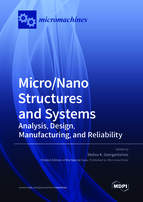Micro/Nano Structures and Systems: Analysis, Design, Manufacturing, and Reliability
A special issue of Micromachines (ISSN 2072-666X). This special issue belongs to the section "A:Physics".
Deadline for manuscript submissions: closed (31 December 2022) | Viewed by 46019
Special Issue Editor
Interests: composite structures; nanocomposites; nanostructures; smart structures and systems; additive manufacturing; finite element method; design; modeling; computational analysis
Special Issues, Collections and Topics in MDPI journals
Special Issue Information
Dear Colleagues,
Over the last few decades, fundamental sciences expanded their length span by many orders of magnitude, one of the primary goals of science and technology, nowadays, seeming to be the quest to develop reliable methods for the prediction of phenomena occurring over multiple length scales, particularly in the nano/micro scale.
Ultra-small structures in the scale of micro/nanometers are used in various applications, including, but not limited to, aerospace, automobiles, etc. Micro/nanostructures are widely used in nano and micro-sized systems and devices, such as biosensors, nanoactuators, nanoprobes, and micro/nano-electromechanical systems, their design relying on the complete understanding of the physical and mechanical behavior of micro/nanostructures. Mechanics plays a forefront role at the micro/nano scale, from the generation of nanostructures through growth instabilities to the properties of nanocomposite materials and the manufacturing and design of machines, structures, sensors, actuators, fluidics, MEMS, NEMS, etc.
The aim of this Special Issue is to assemble high-quality papers advancing the field of micro/nanostructures and systems through the development and application of any modern computational and/or analytical method alone or in conjunction with experimental techniques for their analysis, design, manufacture, maintenance, quality and reliability.
It is my pleasure to invite you to submit a manuscript for this Special Issue, welcoming full papers, communications and reviews.
Prof. Dr. Stelios K. Georgantzinos
Guest Editor
Manuscript Submission Information
Manuscripts should be submitted online at www.mdpi.com by registering and logging in to this website. Once you are registered, click here to go to the submission form. Manuscripts can be submitted until the deadline. All submissions that pass pre-check are peer-reviewed. Accepted papers will be published continuously in the journal (as soon as accepted) and will be listed together on the special issue website. Research articles, review articles as well as short communications are invited. For planned papers, a title and short abstract (about 100 words) can be sent to the Editorial Office for announcement on this website.
Submitted manuscripts should not have been published previously, nor be under consideration for publication elsewhere (except conference proceedings papers). All manuscripts are thoroughly refereed through a single-blind peer-review process. A guide for authors and other relevant information for submission of manuscripts is available on the Instructions for Authors page. Micromachines is an international peer-reviewed open access monthly journal published by MDPI.
Please visit the Instructions for Authors page before submitting a manuscript. The Article Processing Charge (APC) for publication in this open access journal is 2600 CHF (Swiss Francs). Submitted papers should be well formatted and use good English. Authors may use MDPI's English editing service prior to publication or during author revisions.
Keywords
- microstructures
- nanostructures
- MEMS
- NEMS
- nanomechanics
- micromechanics
- additive manufacturing
- devices
- computational techniques
- analytical methods analysis
- experimental techniques
- simulation
- quality
- maintenance
- reliability







